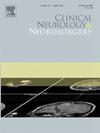Risk of spontaneous intracerebral hemorrhage associated with NOACs compared with aspirin and warfarin: A long-term single hospital follow-up study
IF 1.8
4区 医学
Q3 CLINICAL NEUROLOGY
引用次数: 0
Abstract
Background
Non-vitamin K antagonist oral anticoagulants (NOACs) are currently the mainstay treatment for preventing thrombosis-induced ischemic stroke in patients with atrial fibrillation (AF), deep vein thrombosis (DVT), or previous infarction. However, such management may potentially induce antithrombotic-associated intracranial hemorrhage, leading to significantly adverse clinical outcomes. To investigate the risk of spontaneous intracranial hemorrhage (sICH) in patients under therapeutic anticoagulation.
Methods
This retrospective cohort study used a database established by Kaohsiung Veterans General Hospital to estimate the risk of first onset sICH in patients with AF, DVT or previous stroke who were 18 years old or older, and who had been on at least three months continuous long-term treatment with the oral anticoagulants aspirin, warfarin, or NOACs. In addition, we used propensity-score matching to minimize bias and Cox proportional hazards ratio to compare the risk of sICH among patients prescribed these anticoagulants.
Results
We analyzed the data of 546 patients (182 aspirin users, 182 warfarin users, and 182 NOAC users). 180 (20 taking aspirin, 74 warfarin, and 86 NOACs) developed new onset sICH before seven years. No new onset cases were found after 7 years. Importantly, those taking NOACs were found to be at a higher risk of early onset hemorrhage (47.80 %) compared to the groups taking aspirin (11.10 %) and warfarin (47.80 %) with a median time-to-occurrence being 2.50, 4.00, and 4.40 years, respectively.
Conclusions
Though NOACs prevented ischemic stroke, they were used with a higher risk of early onset spontaneous ICH at our large medical center.
与阿司匹林和华法林相比,NOAC 与自发性脑内出血相关的风险:一项长期单一医院随访研究
背景非维生素 K 拮抗剂口服抗凝药(NOAC)是目前预防心房颤动(AF)、深静脉血栓形成(DVT)或既往脑梗死患者血栓形成诱发缺血性卒中的主要治疗方法。然而,这种治疗可能会诱发与抗血栓相关的颅内出血,从而导致严重不良的临床结果。这项回顾性队列研究利用高雄荣民总医院建立的数据库,估算了年龄在 18 岁或以上、至少连续三个月长期接受阿司匹林、华法林或 NOACs 口服抗凝剂治疗的房颤、深静脉血栓或既往脑卒中患者首次发生 sICH 的风险。此外,我们还使用倾向分数匹配来减少偏倚,并使用 Cox 比例危险比来比较服用这些抗凝药物的患者发生 sICH 的风险。其中 180 人(20 人服用阿司匹林,74 人服用华法林,86 人服用 NOAC)在 7 年前出现新发 sICH。7 年后未发现新发病例。重要的是,与服用阿司匹林(11.10%)和华法林(47.80%)的组别相比,服用 NOACs 的组别发生早发性出血的风险更高(47.80%),中位发病时间分别为 2.50 年、4.00 年和 4.40 年。
本文章由计算机程序翻译,如有差异,请以英文原文为准。
求助全文
约1分钟内获得全文
求助全文
来源期刊

Clinical Neurology and Neurosurgery
医学-临床神经学
CiteScore
3.70
自引率
5.30%
发文量
358
审稿时长
46 days
期刊介绍:
Clinical Neurology and Neurosurgery is devoted to publishing papers and reports on the clinical aspects of neurology and neurosurgery. It is an international forum for papers of high scientific standard that are of interest to Neurologists and Neurosurgeons world-wide.
 求助内容:
求助内容: 应助结果提醒方式:
应助结果提醒方式:


